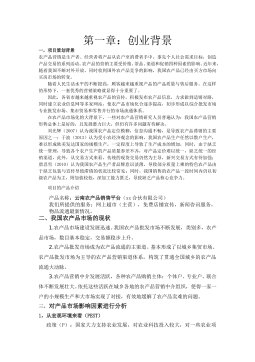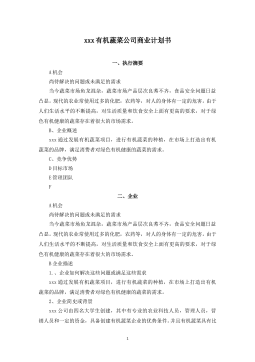数控机床温度测点优化布置和热误差建模研究
摘要热误差是影响高精密数控机床加工精度的重要因素之一。机床在主轴旋转和线性轴线运动过程中,内部热源和环境温度的相互作用使机床产生温度梯度,机床零部件受热不均匀而膨胀变形,造成机床刀具与工作台的相对位置发生热变形,导致加工误差。近年来国内外专家学者的研究表明,减少机床热误差的方法主要有两个方向:一方面通过改进设计方法和制造工艺,对机床结构进行优化设计,提高机床的精度和刚度以降低加工误差,即机床结构优化设计;另一方面通过试验对机床的温度场和变形量进行分析,建立热误差模型,进行热误差补偿。热误差不能在设计阶段被完全消除,当加工精度要求较高时,采用结构优化设计方法将使生产成本显著增加,甚至超过了减少加...
相关推荐
-
人教PEP英语-((开学摸底测试 综合提升卷)2023-2024学年五年级英语上册开学摸底考试卷(一)(人教PEP版)VIP免费

 2024-09-30 8
2024-09-30 8 -
人教PEP英语-((开学摸底测试 重难点必刷卷)2023-2024学年四年级英语上册开学摸底考试卷(二)(人教PEP版)VIP免费

 2024-09-30 9
2024-09-30 9 -
人教PEP英语-((开学摸底测试 重难点必刷卷)2023-2024学年五年级英语上册开学摸底考试卷(二)(人教PEP版)VIP免费

 2024-09-30 7
2024-09-30 7 -
人教PEP英语-((开学摸底测试 综合提升卷)2023-2024学年四年级英语上册开学摸底考试卷(一)(人教PEP版)VIP免费

 2024-09-30 7
2024-09-30 7 -
人教PEP英语-(2023-2024学年六年级英语上册开学摸底考试卷A卷(人教PEP版)VIP免费

 2024-09-30 8
2024-09-30 8 -
人教PEP英语-(2023-2024学年六年级英语上册开学摸底考试卷B卷(人教PEP版)VIP免费

 2024-09-30 8
2024-09-30 8 -
人教PEP英语-(开学摸底测试 易错题精选卷)2023-2024学年五年级英语上册开学摸底考试卷(三)(人教PEP版)VIP免费

 2024-09-30 7
2024-09-30 7 -
外研版英语-(开学摸底测试 易错题精选卷)2023-2024学年六年级英语上册开学摸底考试卷(三)(外研版三起)VIP免费

 2024-09-30 8
2024-09-30 8 -
外研版英语-(开学摸底测试 易错题精选卷)2023-2024学年五年级英语上册开学摸底考试卷(三)(外研版三起)VIP免费

 2024-09-30 8
2024-09-30 8 -
外研版英语-(开学摸底测试 重难点必刷卷)2023-2024学年六年级英语上册开学摸底考试卷(二)(外研版三起)VIP免费

 2024-09-30 8
2024-09-30 8
相关内容
-

2019-2020学年2年级松江区英语上期末试卷答案
分类:中小学教育资料
时间:2024-11-19
标签:无
格式:DOCX
价格:5 积分
-
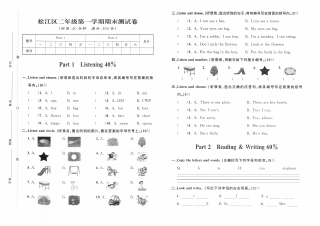
2019-2020学年2年级松江区英语上期末试卷
分类:中小学教育资料
时间:2024-11-19
标签:无
格式:PDF
价格:5 积分
-
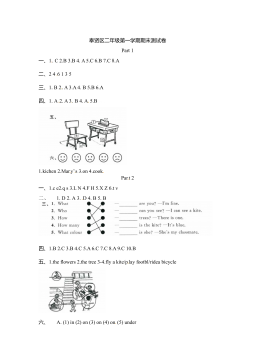
2019-2020学年2年级奉贤区英语上期末试卷答案
分类:中小学教育资料
时间:2024-11-19
标签:无
格式:DOCX
价格:5 积分
-
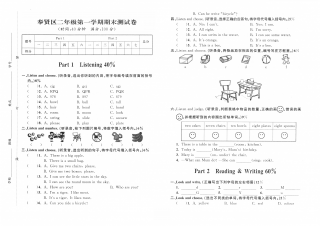
2019-2020学年2年级奉贤区英语上期末试卷
分类:中小学教育资料
时间:2024-11-19
标签:无
格式:PDF
价格:5 积分
-

2021-2022学年牛津上海版(试用本)二年级上册期中模拟测试英语试卷(原卷版)
分类:中小学教育资料
时间:2024-11-19
标签:无
格式:DOC
价格:5 积分


